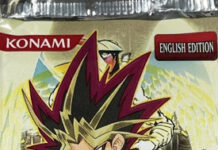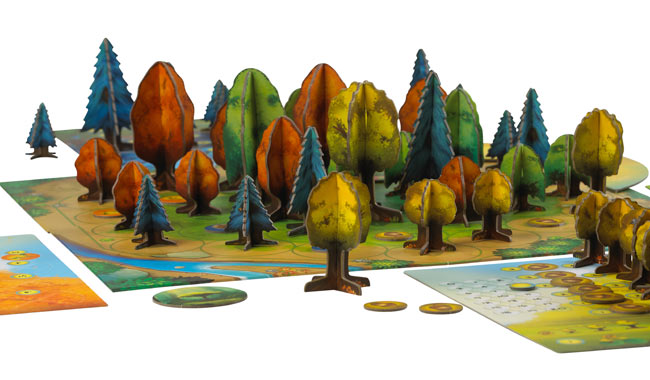
Rush – The Trees:
“There is unrest in the forest
There is trouble with the trees
For the maples want more sunlight
And the oaks ignore their pleas …”
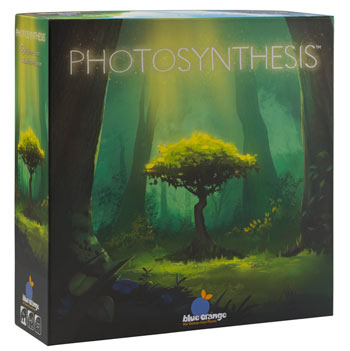
Photosynthesis is a board game from Blue Orange Games for 2 to 4 players. Each player is trying to dominate the forest with their own trees. You grab as much sunlight as you can, and grow as many trees as possible.
Photosynthesis looks glorious and eye-catching when it is sitting out on the gaming table!
Photosynthesis is a unique abstract strategy game in which players plant and grow trees. The Trees catch rays of light which give you light points. You spend these light points like money to buy seeds, plant trees, and grow trees.
But other trees can shade your trees, rewarding you with no light points. The sun rotates around the forest where you and other players have planted trees. The strategy is knowing where and when to plant your trees in order to give you the best shot at winning the game.
What’s in the box?
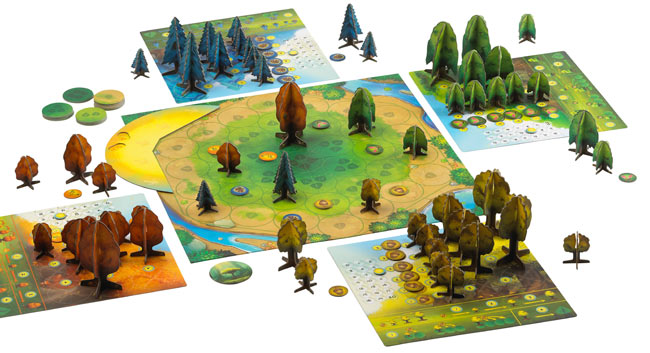
The box contains:
- 1 Game Board – where you plant your trees
- 1 Sun Segment – that is rotated around the board to change angles of the sun
- 4 Player Boards – where each player keeps their personnel stock of trees
- 1 First Player Token
- 24 Scoring Tokens
- 4 Sun Marker Tokens
- 24 Seed Tokens (6 of each species)
- 32 Small Trees (8 of each species)
- 16 Medium Trees (4 of each species)
- 8 Big Trees (2 of each species)
- Illustrated Rules
How do you play Photosynthesis?
Here is a quick tutorial on how Photosynthesis is played.
At the beginning of the game, each player gets to plant two small trees on the outside of the board. And the sun will start off in a corner of the gameboard. Your goal is to maximize tree growth in the time it takes for the sun to circle the game board 3 times. The game board is essentially hexagonal, and it takes 6 rounds for the sun to go around the board one time. So, everyone will get 18 turns each game.
Each Round has two phases:
- The Photosynthesis Phase – where you collect sunlight points
- The Life Cycle Phase – where you take actions with your collected sunlight points
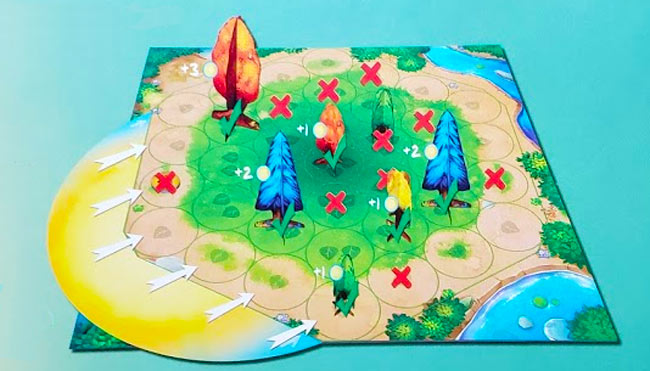
The Photosynthesis Phase
All players collect points if their trees are collecting sunlight (not in the shadows of other trees).
- Small trees collect 1 pt.
- Medium trees collect 2 pts.
- Large trees collect 3 pts.
- And seedlings collect 0 pts.
But you must account for shadow sizes on the opposite side of the sun.
- Small trees cast a shadow 1 space
- Medium trees cast a shadow 2 spaces
- Large trees cast a shadow 3 spaces
Trees cast shadows over other trees, including their own variety. A tree standing in the shadow of another tree will still earn light points if it is taller than the tree shadowing it.
In the example above (from the rulebook),
- the orange trees earn 4 light points
- the blue trees earn 4 light points
- the green trees earn 1 light point
- and the yellow trees earn 1 light point.
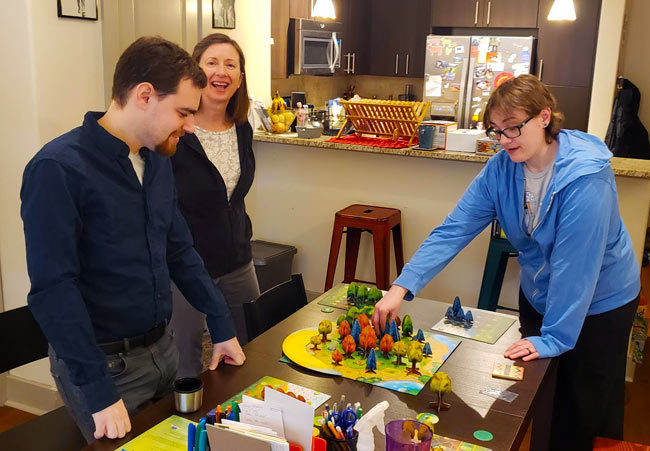
The Life Cycle Phase:
This is when you spend your light points
- Buying – Players can buy seeds and trees from their player boards
- Planting a Seed – Players can plant a seed around their existing trees
- Growing a tree – Players can grow a tree to its next size
- Collecting – Players can choose to chop down a large tree to collect a scoring token
These all cost various sunlight points. I don’t want to get too involved here explaining the life cycle phase, but some of the finer points are:
- Taller trees can throw their seeds further than smaller trees, letting you spread around the board faster.
- Victory Points are only awarded after you grow a tree to full size, and then chop it down. Okay … the game doesn’t officially call it chopping down a tree, they call it “Ending the Life-Cycle”. So, you’re pretty much chopping down dead trees. 😉
After each player has has taken a turn, the sun advances to the next Photosynthesis Phase. When the sun has completed 3 revolutions around the game board, the game is over. The person with the most points on their scoring tokens wins.
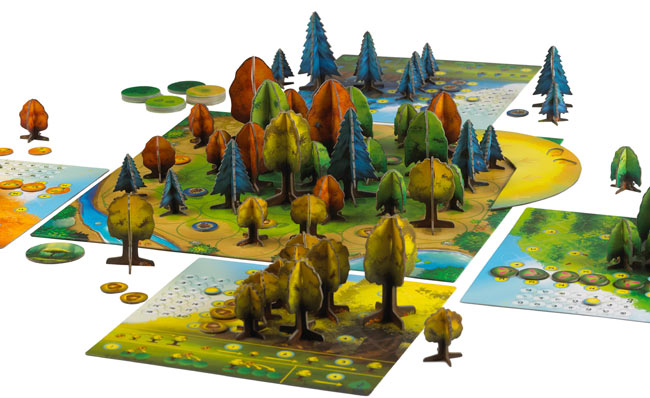
Pros and Cons of Photosynthesis
Pros:
- Theme – The theme makes total sense!
- High Quality Components – The trees are sturdy, and stand up nicely. Everything here seems well-made. I haven’t had any trouble with trees falling apart.
- Looks – This game looks great on the Table. This is one of those games that is simply stunning and eye-catching.
- Easy to Teach / Easy to Learn – This is not a difficult game to learn and teach. Everyone understands that trees start off as seeds, and eventually grow to be larger trees. But it might be a bit difficult for youngsters to grasp the sun/shade concept for scoring sunlight points. The box says ages 8 and up, but I think 10 and up might be more appropriate.
- Box Design – All the components fit nicely back into the box.
- Rulebook – The rulebook is large, in full color, and only 4 pages. The rulebook explains the game quite well and has plenty of explanatory photos.
- Strategy – Looking at this game from afar, it’s hard to tell if the strategy is simple or difficult. You need to get trees planted and get them growing in order to make sunlight points. But you also need to chop them down in order to get Victory Points. But when you chop them down, they stop making sunlight points. You also need to plan ahead and predict where the sun will be in future turns, and how many other trees will shade your tree during those future turns.
Cons:
- Take That! – There is a little bit of “Take That!” going on here. This can’t be avoided in this Photosynthesis. Your opponents need sunlight too.
- Punch Outs & First Time Assembly – This is one of the most tedious games I have put together in recent memory. There are over 150 things you have to punch out from the cardboard punch outs before first use. Each tree is two punch outs and then you have to assemble them. I’m guessing this process took me 30-60 minutes of tedium before our first game.
- Crowded Board – In a 2-player game, the board is wide open. In a 4-player game, the forest can get pretty crowded, and adding up sunlight points can be a struggle for people with poor math and geometry skills.
- Downtime – There is not much to do during other people’s turns (aside from making sure they don’t break any rules). The box says 60 minutes, but I’m guessing that’s for experts. I think 90 minutes is more realistic.
Final Thoughts
This is a fantastic game! You can attempt various strategies during gameplay. Should you sow a seed? Or is it better to use your points to grow some trees? Or is it time to break out the axe? The forest theme is phenomenal and makes total sense in this application.
This is a great game for 2 players. It’s an easy recommendation for playing with your “gaming” significant other.
This can also be a great family game if your kids have a simple grasp of geometry and math. This can also help kids gain an understanding on math and geometry as well. Kids will get a visual understanding on how shapes might block sunlight from other shapes. It’s sly, and rudimentary physics.
I highly recommend Photosynthesis as something different from your usual fantasy gaming fare.



